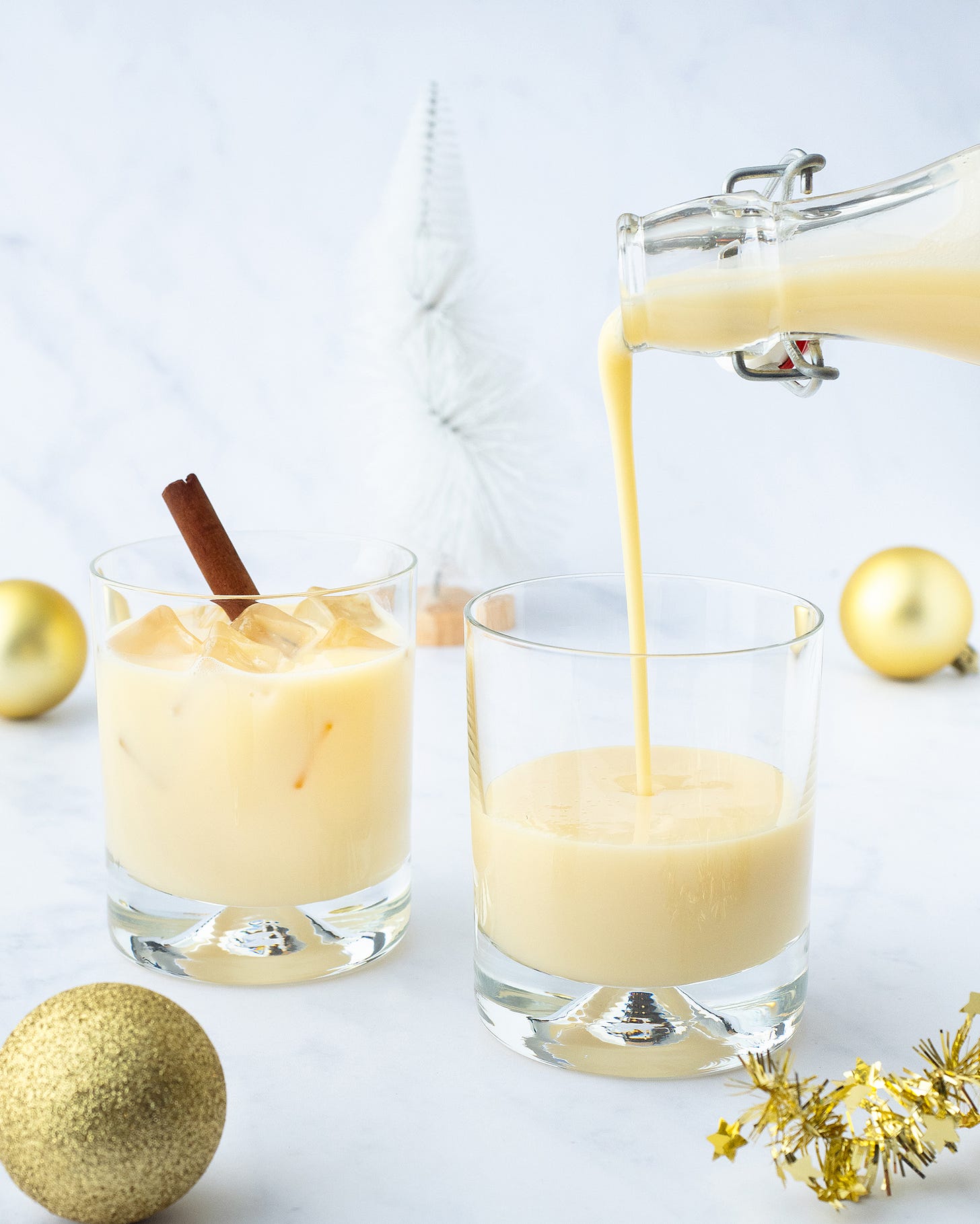Crema de Vie: A Cuban Eggnog-Style Holiday Drink
A tradition that survived the decades without Christmas.
In the United States, eggnog is a staple of the holiday season, with or without alcohol, so it is safe to say that if you live in the US, you have at least heard about it. But egg punches in various compositions are popular drinks around the world, and many make use of locally produced ingredients. Mexico has rompope. Peru has biblia, which, oddly, is also the Spanish word for Bible. Germany has eierpunsch, literally egg punch. Colombia has sabajón. Scotland has Auld man’s milk. Denmark has Æggekop. The Netherlands have advocaat. Japan has tamagozake, though not a holiday drink necessarily. And the list goes on.
Cuba has what is known to the world as crema de vie. The name is a mix of Spanish and French, but the concoction is thoroughly Cuban in spirit, literally and figuratively. I say that the world knows it as crema de vie, but I grew up hearing it called lechita, which is the Spanish diminutive for leche (milk). It has always been a holiday drink, made in small quantities in people’s homes.
But here is the thing, between 1969 and 1998 there was no Christmas in Cuba. It is a well-known tenet of communism that religion is antithetical to that political ideology. Karl Marx famously wrote that religion is the opium of the masses, and that the abolition of religion as “illusory happiness” was necessary for real happiness. Vladimir llich Lenin reiterated that belief when he said that true communism would always promote atheism and fight religion. Religion, Lenin claimed, robs people of their agency and keeps them oppressed. He also called religion “a sort of spiritual booze,” which, I suppose, relates to drinking rum-spiked egg punch during Christmas in a very funny way.
So, with no place for religion and its celebrations in a Marxist-Leninist society, the Fidel Castro regime banned Christmas – although Cubans actually celebrate Christmas Eve (Noche Buena) and not so much Christmas Day itself. It wasn’t until 1998, when the Pope visited Cuba for the first time, that Christmas was once again officially recognized by the Cuban government. Yet, some traditions persisted, even through the terrible years of the Special Period and its intolerable scarity. Lechita, or crema de vie, was one of them. I have vivid memories as a kid of the conviviality of adults sharing a sip of lechita made with an almost impossible to find can of condensed milk and near-extinct eggs. It was a spark of joy in a world where joy was hard to find amidst the harsh reality of barely subsisting. It was a moment of excess in a life of scarcity. It made people happy. Maybe it was the indulgence of it all; maybe it was the booze. And, let’s be clear, crema de vie is always boozy.
This quintessential recipe for crema de vie is adapted from the 1980s edition of Nitza Villapol’s Cocina al Minuto, a canonical Cuban cookbook. The recipe as written in the book calls for 1 ½ cups of condensed milk, which is just over one can. Who wants to open a whole can of condensed milk for just ¼ cup? Not me. The recipe here calls instead for one can, which is about 1 ¼ cups. I have made the recipe using both measurements and the results were the same. Neither flavor nor consistency changed.
The original recipe calls for either rum or aguardiente. The latter, which translates roughly into “burning water,” is a distilled spirit, like rum, but it isn’t rum because it is not aged. It is very popular in Cuba and other Spanish and Portuguese speaking countries. If you have access to aguardiente by all means use that, but I suspect most people will have better access to rum.
I made some change to the recipe instructions for clarity as it was very brief in parts that it assumes knowledge, mainly in the making of the syrup. It just said “Make a thick syrup with the water, sugar, and cinnamon or star anise.”
If all the egg punch you’ve ever had is anemic eggnog with a drop of brandy, prepare to have your socks knocked off. This is a strong drink!
Crema de Vie
1 cup water
1 cup granulated sugar
1 cinnamon stick or whole star anise (cinnamon is more common)
2 eggs
½ teaspoon salt
1 can (1 ¼ cups) condensed milk
¾ cups white rum
1 tsp vanilla extract
Place the water, sugar, and cinnamon or star anise in a small saucepan over medium heat. Bring to a boil, without stirring, and boil for about 6 to 7 minutes. If you need to get some sugar to dissolve, you can gently swirl the saucepan. Turn the heat off and allow the syrup to cool completely.
In a large bowl, beat the eggs and the salt until creamy and thick. Add the cooled syrup, condensed milk, rum, and vanilla extract. Mix well with a whisk or hand mixer until fully combined and creamy, approximately 3 minutes.
Serve very cold with crushed ice.
Some people say to age crema de vie two or three weeks. I don’t think it will last that long before it’s all gone. Do keep it refrigerated while it lasts though.
Happy holidays!
What I’ve Been Reading
I just finished reading (well, listening to, I love audio books), Why Food Matters by Paul Freedman. Freedman, an academic historian who has recently started writing books about food history for the general public, makes a very engaging case for why food, well, matters as a lens through which to study people and societies.
What I’ve Been Cooking
I spent the Thanksgiving weekend making the components for Hakata-Style mountain of scallions ramen from the cookbook Ramen Obsession. I made the tonkotsu broth, shio tare, and chashu pork. Then finally put it all together on Sunday. I know it doesn’t look like much, but it was so good! Absolutely worth the effort, including the incredible awkwardness of shopping for groceries at a local Asian market where the butchers speak no English and I, of course, do not speak their language. In the end it all worked out.
Also on the Thanksgiving weekend I finally made Parmesan broth after two years of meaning to do so. It uses Parmesan rinds, which I got from the cheese counter at a big grocery store here in Brooklyn. They didn’t have any on display so I just asked for some and they cut them for me right then and there. I have seen Parmesan rinds in the fridge at Whole Foods though. I used the broth in a white bean, pasta, and kale soup from the cookbook Pasta Everyday (with some modifications). The recipe for the Parmesan broth is in the same book. Delicious.







In 1640, in an attempt to forbid anything that was related to Roman Catholicism, the Scottish Parliament passed a law that made celebrating Yule (Christmas) illegal. England & Wales passed a similar law in 1647. In 1660 Christmas celebrations were restored in England & Wales, but they continued to be discouraged in Scotland. It was not until 1958 that Scotland had a bank (public) holiday on 25 December, and it took a couple of decades before Scots fully embraced Christmas celebrations - which is why New Year celebrations became so important in Scotland.
My family is from the USVI, St. Kitts, and Barbados and when the Poché Kuba comes out, the holidays begin! Thank you for sharing the history behind the iconic drink that connects us throughout the Caribbean, and for giving me a rabbit hole to spend the rest of the day in!